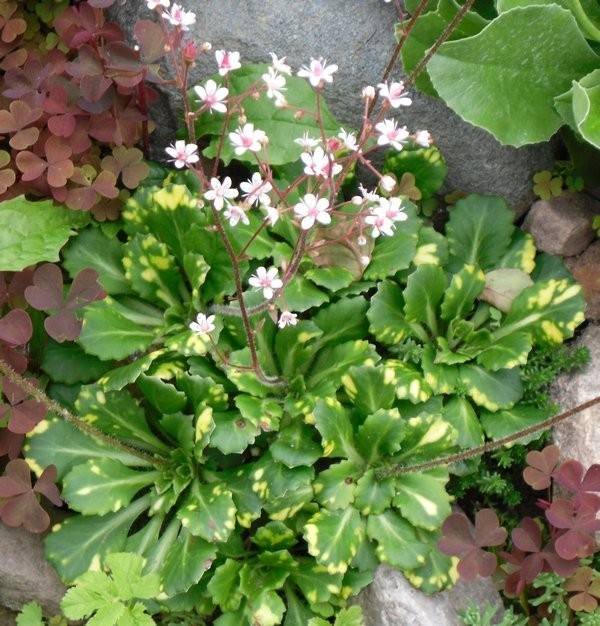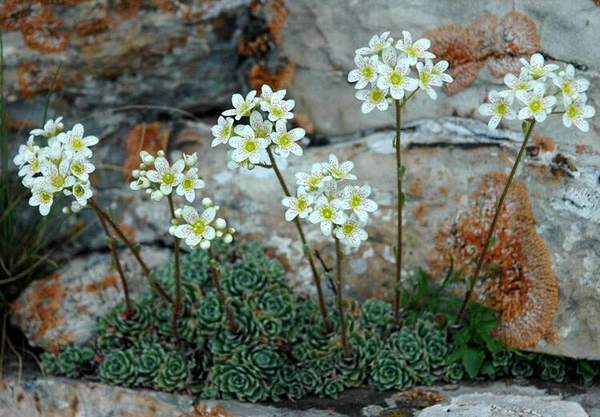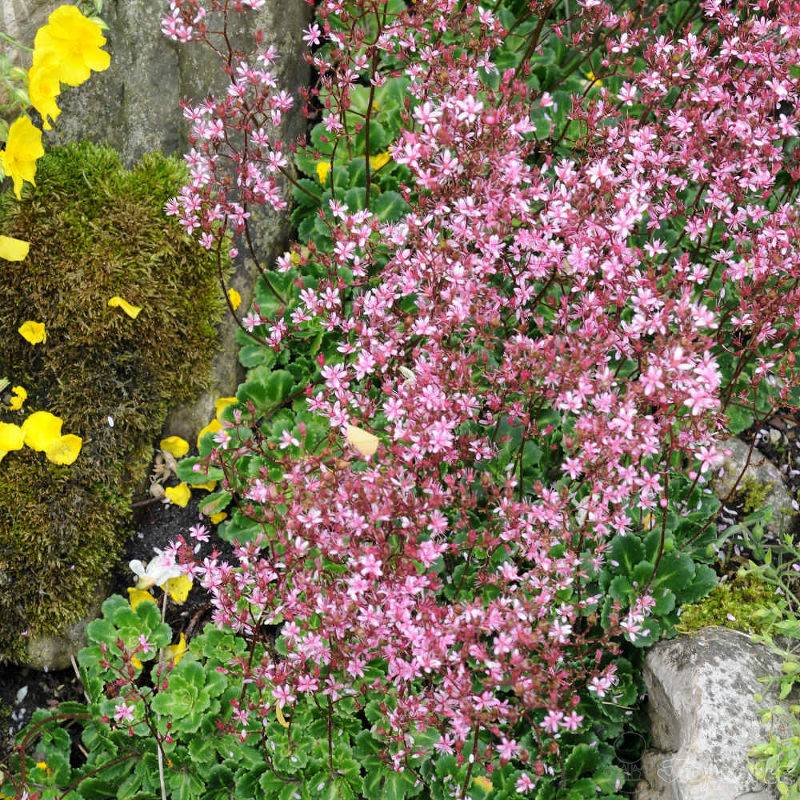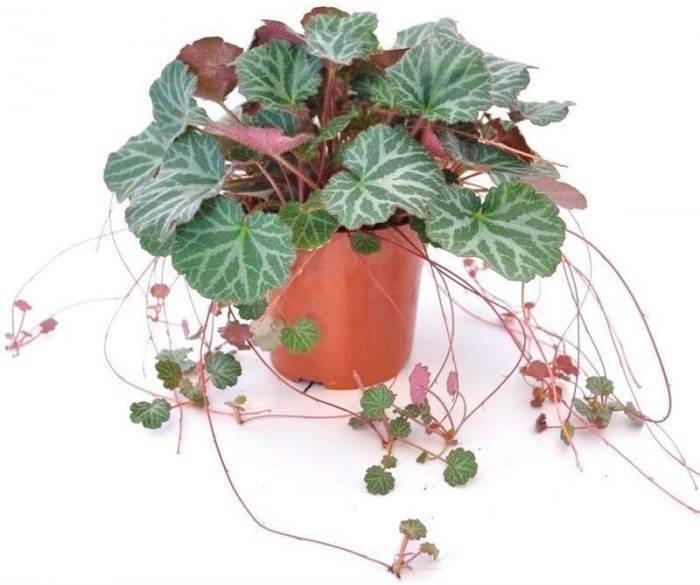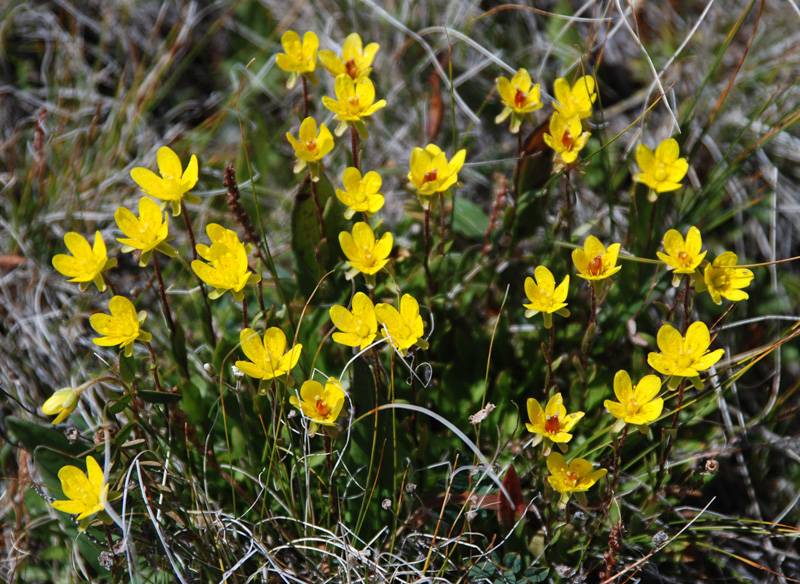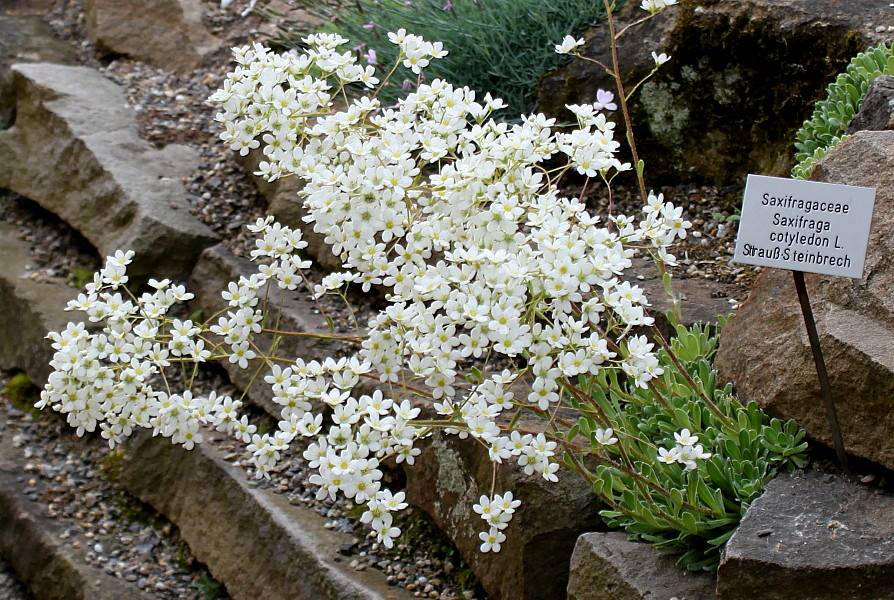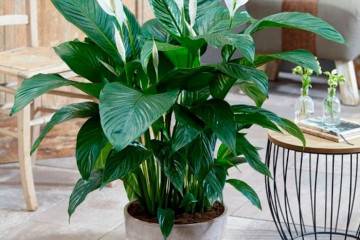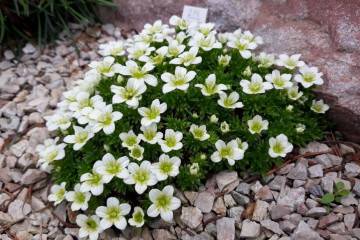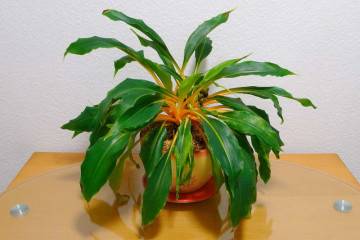Popular varieties of saxifrage flower - description
Content:
- Biological description
- Popular species and varieties
- Arends (Saxifraga Arendsii)
- Three-fork (Saxifraga Trifurcata Schrad)
- Saxifrage paniculata (Saxifraga Paniculata)
- Shadow saxifraga (Saxifraga Urbium Variegata)
- Wicker saxifraga (Saxifraga Stolonifera)
- Soddy (Saxifraga X Arendsii Engl)
- Saxifrage mossy (Saxifraga Bryoides L.)
- Round-leaved saxifraga (Saxifraga Rotundifolia L.)
- Features of plant care and growing
The genus saxifrage includes more than 400 plant species. An unpretentious plant that is resistant to a harsh climate is actively used as a ground cover in flower beds, alpine slides, rock gardens. Designers are attracted by ease of maintenance, high decorative effect, variety of shapes and sizes. Also saxifrage is used as a houseplant.
Biological description
Homeland of the shadow saxifrage of the Alps. The plant feels good in a harsh mountain climate, settles in crevices of rocks and on scree.
Representatives of the saxifrage genus are species with a powerful perennial rhizome, which allows them to gain a foothold on rocky ground, provide food to a rosette of fleshy or leathery succulent leaves. The shape of the leaves is highly variable. Often, the edges of the leaf plate acquire a gray tint due to the large amount of lime.
Popular species and varieties
Most often in Russia in gardens and parks you can find the following varieties of flowers:
Arends (Saxifraga Arendsii)
This species is represented by a large number of varieties. Glossy leaves are collected in rosettes up to 20 cm in height. On peduncles several large white, yellowish or pink flowers. Flowering occurs in May.
Three-fork (Saxifraga Trifurcata Schrad)
15-30 cm high. The plant forms loose openwork tussocks. They are formed from daughter rosettes spreading along the ground with the help of vegetative shoots. The leaves are small, 2 cm in diameter, deeply dissected, sitting on petioles 3-5 cm. White flowers are collected in 10-15 pieces. in umbellate inflorescences. Flowering starts in July.
Saxifrage paniculata (Saxifraga Paniculata)
A perennial herb forms spherical basal rosettes, collected in tussocks or forming a loose carpet. Diameter of rosettes is up to 10 cm. Peduncles are erect. Rosette leaves are fleshy, gray-green with lime inlay. The flowers look like open creamy white bells, which are collected in panicles 5-15 cm long. Flowering begins in June.
Paniculate view
Shadow saxifraga (Saxifraga Urbium Variegata)
Fleshy leaves, covered with fluff, purple below, glossy above, dark green, collected in a dense rosette up to 8 cm in height. Peduncles rise 15 cm above the soil. The flowers are small, light pink or white with a crimson center, collected in a panicle inflorescence. Numerous rosettes, united by underground shoots, form a dense, beautiful carpet.
Advantages of the view:
- high frost resistance, even without shelter;
- resistant to pests and diseases;
- quickly recovers in case of mechanical damage;
- shade-tolerant, but not afraid of sunburn
Clarence Elliot forms a dense carpet of greenery. The height of the bush is 20 cm. It has red stems, pink stars and small dense leaves.
Interesting variegated varieties have also been bred.
Wicker saxifraga (Saxifraga Stolonifera)
The bush is up to 50 cm across. The leaves are rounded with slight pubescence.The edge of the plate is uneven white or brown. The upper side of the leaf is green, the lower side is burgundy with white specks. Long stolon shoots look like filamentous whiskers. Flowering occurs from May to August. It is inconspicuous, but the flower is interesting for its complete lack of symmetry.
Soddy (Saxifraga X Arendsii Engl)
A combined group that includes hybrids obtained with the participation of loose saxifrage, pink, etc. These are perennial light and moisture-loving plants. Form dense cushions 10-20 cm high. Peduncles are straight, weakly leafy. Numerous finger-dissected fleshy leaves are collected in wintering rosettes. The flowers are similar to saucers or cups with a diameter of 1-1.5 cm, pink or white and creamy yellow. Flowering occurs in May-June.
Saxifrage mossy (Saxifraga Bryoides L.)
Light and moisture-loving herbaceous perennial. The name of the species is associated with the fact that, growing, it forms a thick carpet of turf, similar to moss, 3-10 cm in height.
Flowering stems up to 15 cm devoid of leaves, they are brown, decorated with white single flowers with a yellow center. On short vegetative stems, small rosettes of lanceolate leaves with a bristly edge are formed. Peak flowering in July-August.
Round-leaved saxifraga (Saxifraga Rotundifolia L.)
This species forms dense, rather high bushes of 30-60 cm, thickening with age, while the diameter remains almost unchanged. The plant is perennial, shade-loving. The leaves are rounded with a crenate edge and fleshy. The diameter of the flower is up to 2 cm, it is white with crimson spots. Blooms from July to September.
Other types and varieties:
- opposite-leaved saxifrage - miniature species. Dark green leaves grow very densely, rosette up to 4 cm tall, peduncles with red-violet flowers 1 cm in diameter;
- marsh with a height of 10 to 40 cm. Erect stems, rosette of leaves at the base. Light green lanceolate leaves. Bright yellow flowers are located on peduncles 3-4 pcs. Blooms from August to September;
- homemade saxifrage is used as an indoor flower. Climbing saxifrage can often be seen in pots, there are also varieties specially bred for window sills;
- stiff-leaved saxifrage. Blossoms with yellow inflorescences in June-July. Forms a loose turf;
- Manchurian saxifrage. White-pink flowers in loose inflorescences, light green leaves;
- saxifrage Purple Mantle. The variety is distinguished by bright scarlet flowers and a moss cover of rosettes;
- snow saxifrage - an inhabitant of Taimyr. Grows on soddy substrates. Dissolves yellow flowers in July. Feels best in snowy places;
- host's saxifrage. Forms open sockets. Highly decorative;
- wedge-shaped. There is a yellow spot in the center of each leaf. Small white flowers are collected in delicate inflorescences;
- Cotyledon is the most beautiful species. The variety has a dense bright rosette of leaves with a diameter of 20 cm and many snow-white flowers, collected in a pyramidal inflorescence up to 60 cm high and up to 40 cm wide.
Features of plant care and growing
Shady saxifrage is an unpretentious plant, even a novice gardener will successfully grow it in his rockery or on an alpine hill. It is necessary to take into account only a few nuances, and the grateful flower will delight with delicate flowering and a bright green carpet of rosettes.
Soil and landing site
The soil can be any. The plant is undemanding neither to the composition nor to the fertility of the substrate. The only condition is the presence of limestone; when planting, you need to add a small amount of lime to the hole.
When choosing a place, you need to solve the issue of the growth restrictor.
The landing site can be any.Shade-tolerant saxifrage feels great in low light conditions. The flower will look best among the stones.
Landing
The optimal time for planting is spring. Sowing seeds in open ground is carried out in April.
Before planting, the soil must be prepared; for this, a small amount of lime, peat, sand, gravel is introduced.
Planting seedlings is carried out according to the following algorithm:
- Dig small holes.
- Place a seedling in the hole.
- Bury the seedling in the ground.
- Water abundantly.
Care
Caring for a "resident" of mountainous regions, accustomed to harsh winds, cold weather and lack of nutrients, is not at all difficult. Shade saxifrage easily tolerates heat, drought and frost.
- Watering. Only when necessary, even in the heat, excessive watering can be harmful. It is only necessary to control the water content in the soil when the plant is very young. A healthy adult flower, covering the soil with a carpet of rosettes, independently regulates soil moisture.
- Top dressing. For active growth and lush flowering, you need to feed with mineral fertilizer every 4-5 weeks. Feeding with nitrogen-containing fertilizers is unacceptable, since an excess of nitrogen will provoke fungal diseases.
- Weeding. Saxifrage variegat, covering the surface of the substrate, inhibits the growth of weeds. Removing weeds is only necessary in areas free from outlets.
- Shelter. It is necessary to shelter for the winter only if the winters in the growing region are very cold and with little snow. In other cases, a frost-resistant plant does not require shelter.
Shady saxifrage will require very little attention and care, but it will delight with flowers and greenery all summer long. She will become a welcome guest in a mixboard, on a flower bed or on an alpine slide.
Video
